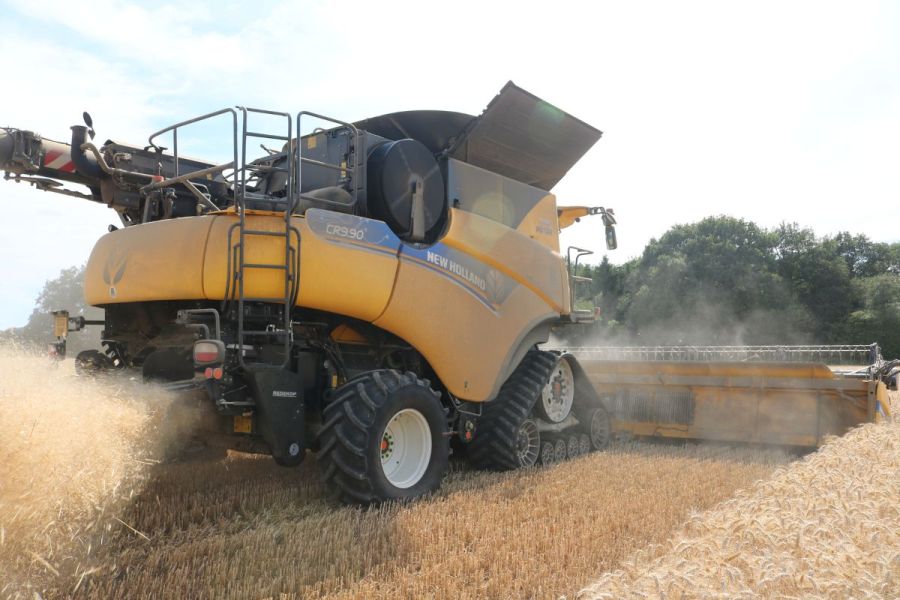A farmer-led trial is putting harvest weed seed control through its paces. CPM visits a farm in Warwickshire with a New Holland combine harvester fitted with a Redekop seed control unit.
“I’m not expecting a silver bullet, but something that will play a part in how we manage grassweeds.”
By Tom Allen-Stevens
There’s a sense of determined exasperation from Ted Holmes as he moves through his crop of Skyfall. This field is ready for harvest, but he’s left it until last, because it’s teeming with ryegrass.
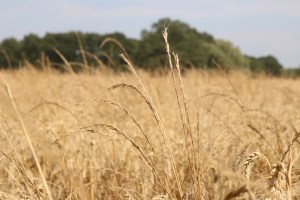
The amount of ryegrass seed still standing at harvest is a crucial part of harvest weed seed control.
“It’s like you’re playing tennis with this weed – just when you think you’re on the front foot, it snatches back a series of points, and you find yourself fighting again to stay in the game,” he says. “The other trying aspect is the extended germination period it has.”
He takes some heads of ryegrass in his hand to demonstrate. “Some of these germinated in the autumn, and the seed just falls out if you brush past them. Then there are other plants you don’t even notice, then just before harvest they throw up their heads, are still green and haven’t fully ripened.”
It’s this aspect – the amount of seed still standing at harvest – that’s a crucial part of a farmer-led trial Ted’s taking part in. From the nearby field you can hear the farm’s New Holland CR9.90 bringing in another crop of Skyfall. More rather you hear the distinctive whine of the Redekop Seed Control Unit (SCU) fitted to its rear to intercept the chaff stream and pulverise any weed seed the combine takes in.
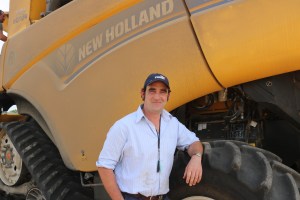
Ted Holmes is looking to bring something else into his integrated approach to maintain control of grassweeds as the efficacy of the chemistry ebbs away.
Successfully used in Australia and Canada, the concept of harvest weed seed control (HWSC) has barely caught on in the UK. The Redekop SCU is a step-on from an integrated unit developed by researchers at the University of South Australia, funded by the Grains Research and Development Corporation. It works on the principle that if you hit a weed seed hard enough four times it renders it unviable.
The chaff stream is separated from the straw and passes from the sieves into the SCU that’s fitted below the straw chopper. The mill operates at 2850rpm, passing the chaff at 400 km/h through two rotary sections of columns and three stationary sections. The tungsten-carbide coated mills are reversible to ensure a long life.
Independent testing has found this kills up to 98% of the weed seed that passes through it. But that’s not the issue that’s on trial. Ted, a Velcourt farm manager near Nuneaton in North Warwickshire, is keen to find out how much of this tricky grassweed is passing through the SCU. It’s this quest that’s brought him together with two other growers in the first year of a ground-breaking trial that’s set to shed light on just how much HWSC can contribute to grassweed control.
“I’m not expecting a silver bullet, but something that will play a part in how we manage grassweeds – I’d be happy with around 50% control per annum,” he notes. “We’ve had the ryegrass tested and it’s RRR resistant to contact chemistry, and I believe we’re seeing resistance to flufenacet creep in, too. What worries me is our reliance on glyphosate to keep the weed in check.”
Ted bases the autumn herbicide stack on mixtures and sequences of flufenacet, pendimethalin and prosulfocarb, supplementing these with tri-allate. “We had really good results from Luximo (cinmethylin) in autumn 2022. Glyphosate is still working, and we keep rates high to ward off the risk of resistance.”
Cultivations are changing to keep them “as shallow as sensibly possible” with a low disturbance subsoil where appropriate across the 880ha of sandy clay loam. The plough is used rotationally once every six or seven years on the worst ryegrass fields. “We operate a traffic-light system in how we prioritise for drilling, and any field classed as red is generally OK as long as it’s drilled in the second half of October or left until spring. We find hybrid barley is useful in the rotation due to its competitive nature against grassweeds.
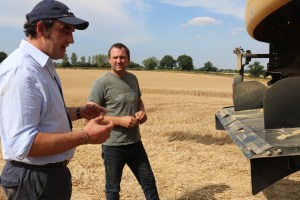
Ted and Pete McKerrell (right) discuss the attributes of the Redekop SCU.
“But ryegrass has been an on-going issue here for 20 years, and we’re looking to bring something else into our integrated approach to maintain control as the efficacy of the chemistry we’re using ebbs away,” notes Ted.
That’s what’s brought him to HWSC, and to the Redekop SCU. He drives the pick-up back to the field where the CR9.90 has just reached the headland. A signal to Pete McKerrell in the driving seat brings the combine to a silent standstill and allows the two of them a close inspection of the curious addition.
Developed first for John Deere combines, the Redekop SCU is also now available for newer Case IH, New Holland and Claas models and can be retrofitted. Like the company’s MAV straw chopper, it spreads residue across the full combine cut-width, although operates independently, so chaff can be milled and straw swathed, or vice versa. The unit that Ted wipes the dust off is the first one to be fitted to a UK NH combine, and a number of changes had to be made, he reveals.
“We had to replace the New Holland Opti-Spread straw spreader with the MAV for everything to fit. I wasn’t entirely happy with this as I’m a great fan of the Opti-Spread, but it’s worth the compromise as I believe the SCU will be crucially important going forwards. The other major change was we had to remove the positive straw discharge (PSD) belt.”
This feeds the straw off the back of the twin rotors into the chopper. While it hasn’t been a huge issue in a dry harvest, Ted’s been sure to feed back detailed reports to Redekop. “There were other niggles with the electrics and sensors that didn’t pick up correctly. But to be fair, Redekop have been brilliant at sorting them out, and we’ve worked closely with their importer, Oria Agriculture, to ensure we’ve barely suffered any downtime.”
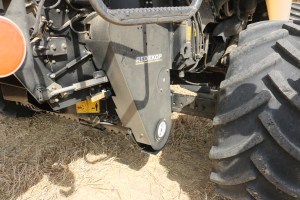
The drive for the low-slung unit comes to the side, so the axle had to be widened to 3.8m to accommodate it.
Redekop and Oria confirm that the design of the SCU for the NH combines has now been altered so concerns that have been raised during harvest 2022 have been addressed. Ted points to one further issue with the rear axle. “It’s a low-slung unit and the drive comes to the side, so the axle had to be widened to 3.8m to accommodate it. This makes it a little awkward moving the machine on our narrow UK roads.”
On the plus side, there’s a simple manual clutch that disengages the drive, which Ted quickly demonstrates. “It’s incredibly easy to engage and disengage,” he notes.
Pete agrees, and adds the unit is also easy to maintain, with a simple daily check. “It largely looks after itself. Once it’s engaged there is more noise and dust, but when you’re up in the cab, you barely notice the difference,” he says.
When Pete arrived on the farm three years ago, he left behind a CR10.90 he operated in Essex for the Warwickshire farm’s Case Axial Flow. But that was swapped out and the current CR9.90 has now completed two seasons. “It’s a fantastic combine,” confirms Ted. “Two rotors are better than one.”
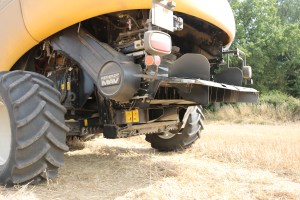
The chaff stream is separated from the straw and passes from the sieves into the SCU that’s fitted below the straw chopper.
So what about the power requirement? Ted confers with his notes. “So we had a 9t/ha milling wheat in lovely hot conditions, with grain coming in at 12.5-13%, chopping the straw. With the SCU engaged as well, fuel use was 18-21 l/ha. If you disengage the SCU this dropped by around 10-12%.
“Now one thing we noticed was that when you lost the sun at the end of the day, the combine got a wee bit thirstier and worked harder, but then you’d expect that whether or not you have an SCU. It’s the same with a fuller crop – we had some KWS Extase doing 11t/ha, swathing the straw this time, but a lot of it, and the combine was drinking 17-20 l/ha with the SCU engaged. Again, disengage the unit and this decreased by about 10%-12%.”
Despite the niggles, Ted is committed to continue with the trial. “We have learnt a huge amount this summer. It’ll be different next year I’m sure, and we need to test the SCU in more trying weather and harvesting conditions to see how it will cope in a more typical UK harvest. But I’m convinced this will become part of the solution to our ryegrass issue, so it’s a thumbs-up from me.”
Trials open new window on grassweed control
Ted is one of three farmers taking part in a trial led by the British On Farm Innovation Network (BOFIN) into harvest weed seed control. The aim of the trial is to test the viability of this window on weed control under UK conditions.
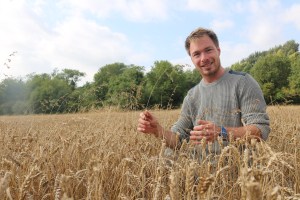
There’s currently very limited data on how much weed seed is available to HWSC machinery at harvest, notes Will Smith.
“The only way HWSC will work is if the seeds are available to the machinery at harvest,” notes Will Smith of NIAB, who’s conducting the data collection and monitoring for the trial. “We currently know little about how much viable seed goes into the combine – there’s very limited work on this in the UK and Europe.”
So Will’s been working with Ted and the other two other farmers involved in the study to put some accurate figures around this. Jake Freestone of Overbury Enterprises in Worcestershire has a Redekop SCU fitted to his John Deere S790i combine and he has a bit of a problem with meadow brome.
In Suffolk, Adam Driver has noticed a build-up of blackgrass in the chaff lines behind his Claas Lexion 8800, running on a no-till 12/36m controlled-traffic farming system. He’s also hoping the SCU keeps meadow brome in check.
Two fields on Ted’s farm were closely monitored, in winter and spring barley, and both had a high Italian ryegrass population. “There are two critical monitoring periods,” explains Will. “Firstly, we want to know the population of viable seed standing at harvest, which involves taking representative samples just before the combine goes through.
“Then we monitor what emerges into the following crop once autumn cultivations and drilling are complete.”
Will’s now developed a protocol for farmers to take their own pre-harvest sample. “It’s impractical to have to wait for a weed scientist before you get the combine out. But just a little instruction on how to sample helped the farmers take good, representative samples. They sent these into NIAB for assessment.
“For Italian ryegrass the figures were 62% in Warwickshire in winter barley and 87% for spring barley. These figures are high, but testing of the seed found that a lot of the IRG seed in the spring barley was unviable, and we think that was due to the hot, dry conditions.”
The surprise result in the 2022 sampling was blackgrass in a field of winter wheat Adam monitored in Suffolk. “We found 54% of this was retained at harvest, so there’s more available to the SCU than we had thought. But we should consider the hot and dry conditions of the 2022 harvest,” notes Will.
So what was the result in the following crop? Will returned to the farms in late October to make a full assessment of emerged grassweeds. “In the field following winter barley in Warwickshire there was a 60% reduction from the SCU. In spring barley, the result was lower – a 44% reduction – but then a lot of the seed was unviable, so we’d expect a lower result.”
The eventual aim of the study is to gather data across a range of crops and key grassweeds to find out the amount of viable seed standing at harvest. “What we’ve achieved this year is a useful snapshot, but we’ll need a lot more growers to take part to build a really valuable dataset,” notes Will.
And that’s the plan for harvest this year. Around the SCU trials, there’s now a knowledge cluster of 140 farmers, scientists and others who have registered interest in the trial and are kept actively involved.
“Feedback from the group has indicated they’re keen to do their own on-farm trials, so we’re going to develop the protocol into a simple procedure any farmer can apply just before harvesting their crop. They’ll receive a full sampling pack with instructions that will give them an accurate picture of how much seed has been shed to help them plan subsequent control.”
The value of sampling has wider implications, he adds. “It’ll build into a rich dataset, across crops, locations and grassweeds, on the efficacy of HWSC. This is data we simply don’t have at present in UK conditions.
“The more farmers who get involved, the more we’ll understand about the efficacy of HWSC and its potential to open a new, completely chemical-free window on keeping the trickiest of grassweeds under control,” concludes Will.
What is BOFIN?
The British On Farm Innovation Network is a group of farmers who carry out their own on-farm trials and share the results, seeking a scientifically robust way to improve farm practice.
Anyone with an interest in HWSC can join BOFIN’s Seed Circle and take part in the sampling trial due to take place during harvest this year – it’s free and there’s no obligation.
They’ll also play an active part in the SCU trials and be first to get the results and experiences of the farmers. To get involved, see the Harvest weed seed control project on Trinity GFP (gfp.global) or visit bofin.org.uk
This article was taken from the latest issue of CPM. For more articles like this, subscribe here.

